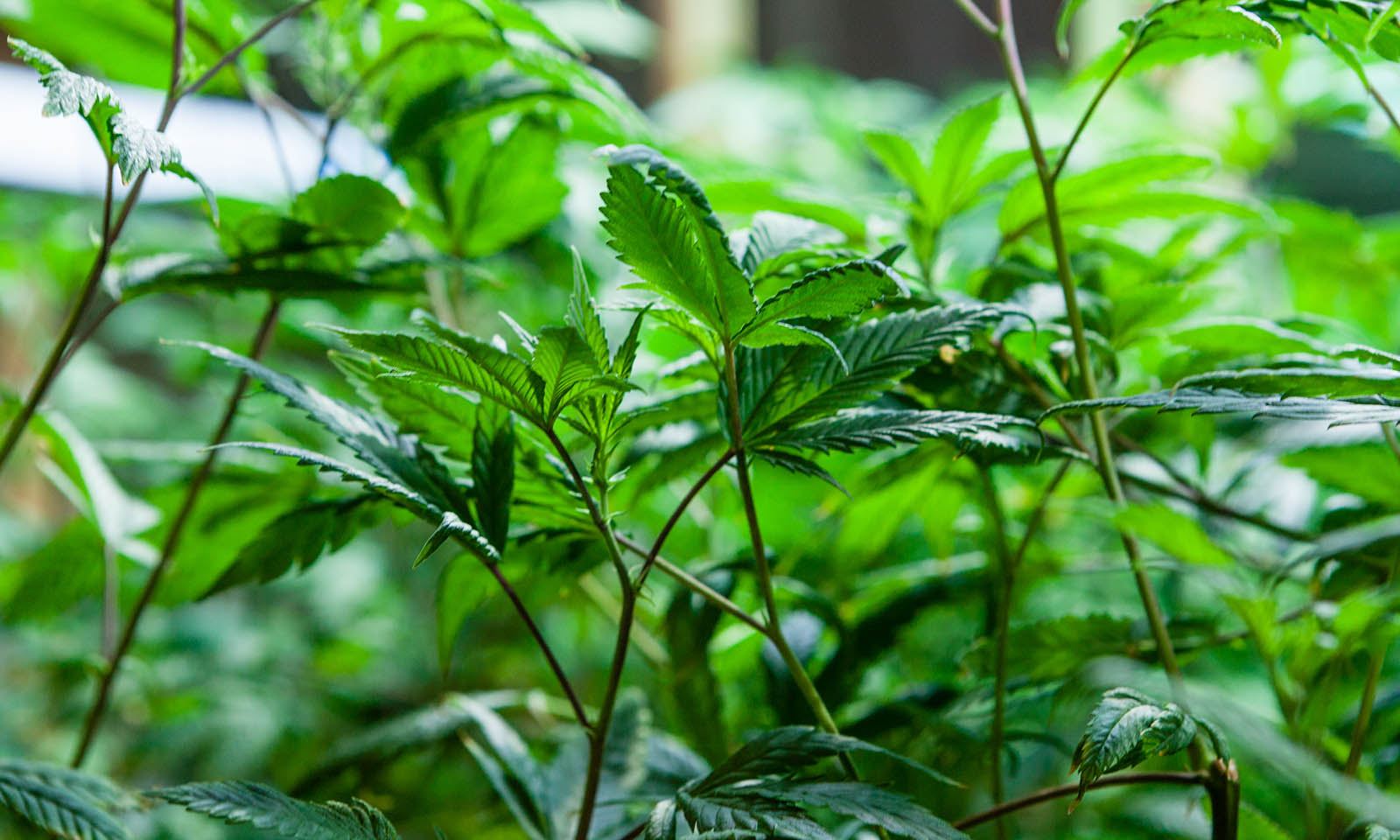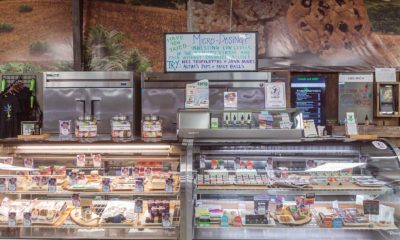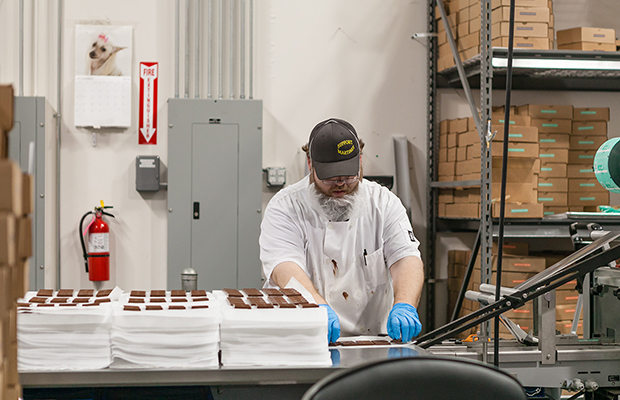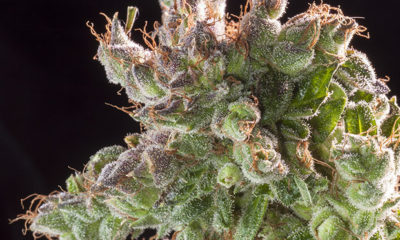The Golden State Blossoms Into Adult Use
Despite some growing pains, California’s recreational companies are looking greener.
California’s $21 billion commercial cannabis industry went legal this January, when the state must issue first-ever licenses for farms, kitchens, labs and stores. All across the state, tens of thousands of operators are working overtime to come into compliance with all local and state laws, get licensed, and start serving adults 21 and older.
“This is going to be the largest transition of any major industry in modern history,” said State Senator Mike McGuire.
Just ask Harborside Farms in Salinas, California, which has become an epicenter of cultivation in the post-prohibition economy.
There, CEO Steve DeAngelo heads up year-round harvesting on a scale never seen before. Harborside has six greenhouses in production, more under construction, and harvested 20,000 plants at once during the summer.
The farm, which serves Harborside’s two medical dispensaries in Oakland and San Jose, has a total of 343 strains, with 24 in production including Zkittlez, Gelato, six high cannabidiol strains and also Slymer, GG #4 and Durban.
DeAngelo hopes to use scale to chop the price of pot by two-thirds to $99 per retail ounce. But the farm encountered constant setbacks this year, including pesticides from neighboring farms that tainted early crops, then late rains and late shipments of equipment — like fans.
What is considered large-scale or “industrial” for cannabis is, in fact, still hand-crafted and artisanal compared with modern agriculture. Dozens of workers harvest from dawn until after dark to capture the potent plant at peak ripeness. They chop down plants by hand, transport them by cart, strip them of leaves by hand and hang them to dry by hand.
“We’re learning, ‘How do you do at scale for the first time?’” DeAngelo said. “A year from now, compared to this — this will seem archaic.”
It’s quite the shift for DeAngelo, who for years has been the world’s biggest pot retailer, not a farmer.
“I never really envisioned myself in the scene from American Gothic,” said DeAngelo. “But here I am.”
Another company groaning with growing pains is Oakland-based edibles leader Kiva Confections. Co-founders Kristi Knoblich Palmer and husband Scott Palmer are living the American dream of starting a business in your home kitchen and growing it to become a leader in the Golden State.
Knoblich says she has ‘pinch me’ moments “like 150 times a day.”
“I haven’t slept in eight years,” said Knoblich, who studied photography at the now-closed Brooks Institute in Santa Barbara where she met her now-husband.
Founded in 2010 in Knoblich’s childhood San Leandro, California home, the company now has 85 employees, 25 different products at three potency levels and handcrafts 15,000 cannabis-infused chocolate units per day in their factory in Oakland. Kiva edibles appear in roughly 1,000 retail outlets across California and offshoot Kiva companies serve patients in Arizona, Nevada and Illinois.
Again, the cannabis world’s idea of “industrial” is the normal world’s idea of artisanal. Kiva started with a single mixer on a residential kitchen counter. “Chocolate is extremely scalable,” Knoblich said.
Nowadays, Kiva workers still hand-transfer chocolate-filled molds to cooling racks in the 13,000 square-foot facility. Kiva custom sources their chocolate 500 pounds at a time for flavor, texture and mouth feel — with no waxes or fillers. “It has to have a silky smooth texture,” Knoblich said.
Kiva had been hand-wrapping each package until a single machine proved 100 times faster. Cleanliness protocols in the building include bug zappers, hair nets, beard nets, gloves, coats, hand-washing and HVAC scrubbers.
“We’re not a mom and pop business anymore,” Knoblich said. “We’ve built a brand people trust.”
With modern legal marijuana regulations, Kiva’s journey cannot be replicated.
“It’s both good and bad,” Knoblich said. “It’s unfortunate you need millions and millions [of dollars] to get started, but it’s a good thing to get product safety standards and people operating above board.”
Much of the unregulated supply chain is tainted, she said, and it’s a struggle to find clean trim. Kiva tests for 280 different pesticides and “the product up north is littered” with them.
Recreational legalization could mean a 400 to 700 percent increase in demand with a 30-day lead time. That means 60,000 units a day, Knoblich realizes, then covers her mouth and says, “Oh my god.”
Across the Bay in San Francisco, boutique cannabis cultivators run year-round in specialized warehouses scattered around town. Among them, Butterbrand produces top-shelf flower and extracts for the medical market, and, like Kiva, also has its eye trained on recreational sales this year, if they can get a local permit to do so.
Butterbrand has four rooms in rotation on an eight-week cycle. They harvest every two weeks starting at 6 a.m. each day with a seven-person crew bringing down Butter OG and other strains.
After the buds dry and cure, Butterbrand uses a single trimming machine, combined with a five-person crew that manicures 15-20 pounds of bud per day. A single high-quality pound can fetch upwards of $2,000 wholesale.
“You can’t replace that,” said Butterbrand CEO Eric Battuello. “We haven’t found any machine that can do the work of humans. … We’re a long ways off.”
As late as November, San Francisco city officials were debating how to license places like Butterbrand, and the growers are not the only one wondering how it’s all going to shake out.
“It’s going to be a sh*tshow,” said Ron Gershoni, co-founder of Jetty Extracts, inside his oil extraction factory in industrial Oakland.
Operators are scrambling to follow last-minute temporary emergency state regulations on things like packaging and labeling — aspects of the business that usually take months to change.
Jetty is four years old with roughly 40 employees and started after Gershoni developed a suspicious neck mole turned out to deadly skin cancer. He survived with help from cannabis, but had to give up surfing at his favorite San Diego spot — the Jetty — and moved his family north for more cloud cover and a better cannabis business climate.
Today, Jetty’s cannabis extracts range from 30 to 90 percent THC and the facility processes more than 1,000 pounds of trim per month. The one-of-a-kind Jetty Dablicator can be found in 300 stores.
Still, “we’re barely making it,” Gershoni said.
Cannabis’ lingering stigma makes hiring top talent difficult, and the heretofore unregulated extract sector is very competitive and saturated. And like seemingly everyone else in the state, it’s hard to find clean source material.
Still, Jetty found the resources to start The Shelter Project, which gives free medicine to cancer patients. And Jetty has partnered with activist group The Hood Incubator to hire local minorities with no industry expertise and train them in the technical art of extraction.
“It’s creating a lot of working-class jobs,” Gershoni said.
Eric Jones, a 29-year-old extraction tech raised on the East Coast said he’s amazed to be thriving in a region as expensive as the Bay Area. Surrounded by whirling oil machines containing tens of thousands of dollars-worth of potent cannabis oil, he said that compared to his friends’ lives on the East Coast, “This is a separate reality we’re living in.”
Even more than $1 billion in annual taxes, California cannabis means tens of thousands of good, high-paying, middle-class, local jobs that often do not require a college degree. Pot’s not some theoretical addition to California’s economic dynamism — it’s here, it’s now and it’s got all the momentum.
David Downs is the San Francisco Chronicle cannabis editor, where he runs GreenState.com. This content first appeared on GreenState.
Originally published in Issue 29 of Cannabis Now. LEARN MORE
TELL US, have you experienced the changes in the California cannabis industry?
























